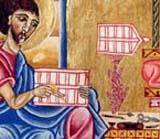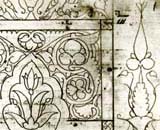|
Organization of the Gospels. As in the European Middle Ages, the entire Bible (Astuatsashunch') was rarely copied as one single volume. Different cultures preferred different parts over the others and in Armenia, the Old Testament sections were copied very rarely. On the other hand, the Gospels (Awetaran) were copied and illustrated in endless variation and today constitute the majority of the preserved manuscripts. Through time, the visual design and textual order of the gospel books become expected if not quite codified. Most Gospel Books begin with the set of ten pages of Canon Tables. The actual tables have a prologue of the Greek theologian Eusebius of Caesarea, presumed inventor of the index system represented in the tables. In Armenian manuscripts this canonical tables are always particularly lavishly decorated and the object of mystical theological research. The numbers surrounded with the rich ornament are meant as meditative device, an archway into the mystery of the divine. Prior to the 12th century the Canon Tables were followed by the cycle of illustrations from the key scenes of the life of Christ. However, after the 14th century these illustrations precede the tables, the feature quite unique for the Armenian tradition. The idea was that the reader would be presented with visual "highlights" of the forthcoming text. The number and selection of the scenes is not strictly determined, and later manuscripts tend to have more panels than the older ones. The Canon Tables are followed with the portraits of the evangelists and incipit pages of the respective gospel books (Matthew, Mark, Luke and John). In the oldest manuscripts, the evangelists were portrayed together on one page, emphasizing the harmony of the message regardless of apparent differences. In later manuscripts, each evangelist becomes portrayed individually, usually in the act of writing the book. The Cilician school, influenced by European iconography, introduced the evangelistic symbols into the portraits and the initial letters of incipit gospel pages become stylized on the evangelist symbol. In particularly luxurious manuscripts, in addition to a prefatory cycle of images, the text is interspersed with illustrations of various sizes. In the Gladzor Gospels illustrations inside text vary from full page to just half of the individual column. Usually they are placed in the appropriate place of the textual narrative. As colophons, dedicative miniatures or portraitures of the sponsor of manuscript were very common in Armenian manuscripts. There is no rule where they should appear or how the sponsor should be represented. Commonly they are represented as offering the Gospel Book to Christ or Mother of God. Lacking any other visual images of contemporary Armenians, these miniatures are particularly valuable for the research of Armenian history. Script. The original Armenian script, created in 5th century, an uncial erkat'agir or "iron" script was a primary script for the liturgical books. Sometimes in 9th century a cursive miniscule bolorgir or "round" script was developed. Facilitated by the need of secular notary scribes in 17th century emerged very condensed notragir script. Initials and rubrication. The pericope (chapter) initials are formed by large tubular letters or birds. The first lines are in large gold erkat'agir script while rest of the text continues in regular bolorgir. Sometimes that pattern is changed and the second line is also in black or red erkat'agir script. Initials of the verses and of nomina sacra are in gold erkat'agir script or bolorgir script. The titles of the individual gospels are written on the incipit and explicit page of the text. In manuscript tradition, especially liturgical texts, the initial letters, and the incipit pages would be written in erkat'agir script. Very often, as it is case in the Gladzor Gospels, the first pages would be written in erkat'agir script combined with zoomorphic pericopes. The zoomorphic alphabet (predominantly birds) was very popular and often the whole incipit line would be written in it. Scribes.The text of the Gladzor gospels is laid out in two 21-line columns and written by two different scribes. The first (principal) scribe wrote in bolorgir script the entire text of the gospels, prefaces and indexes that appear before each gospel. The second scribe wrote the information of the Canon Tables, the text of the Eusebian Introduction and, through the codex, numbers (in black ink) that relate to the Eusebian division of the text. Through out the codex he indexed (in red ink) the passages in gospels to their corresponding canon tables. Also, in the individual gospels, he marked the chapter numbers (numbers within the circle in blue ink) which correspond to the index preceding a gospel. In the traditional Armenian number system, the letters of the alphabet are used as numerals. The colophons, inscriptions and rewriting of the prefatory material before the Gospel of Matthew were added in later centuries. In the usual process of the manuscript production, scribes would write the whole text and outline the basic page design before passing the quires to the painters. However, in the case of the Canon Tables, which were in the separate gathering, the painters were the first to execute their part of the job and text was written by the scribe afterwards. The hand copying of the manuscripts, particularly the Gospels, continued into the 19th century. Although the first Armenian books were printed as early as beginning of 16th century (1512-1512 in Venice by Hakob Meghapart), the free labor of monks in monasteries remained much more economical form of book reproduction. There was also, as elsewhere, a resistance of scribes and illuminators, partially because of the economic and aesthetic reasons, and partially because of the spiritual investment that was associated with the creation of a religious manuscript. More about the Armenian Script on Omniglot web site... Bibliography: Mathews, T. F. (2001). The Armenian Gospels of Gladzor: The life of Christ illuminated. Los Angeles: The J. Paul Getty Museum. Mathews, T.F. and Wieck, R.S. (Ed.). (1994). Treasures in heaven: Armenian illuminated manuscripts. New York: The Pierpont Morgan Library. Orna, M. and Mathews, T.F. (1981). Pigment analysis of the Glajor Gospel book of UCLA. Studies in Conservation, 26(2), pp. 57-72. Sanjian, A.K. (1999). Medieval Armenian manuscripts at the University of California, Los Angeles. Berkeley: University of California Press. Thomson, R. (1997). Armenian literary culture through the eleventh century. In R. G. Hovannisian (Ed.), The Armenian people from ancient to modern times (Vol. I, pp. 199-239). New York: St. Martin's Press. Copyright 2006, Vlasta Radan, all rights reserved. |



